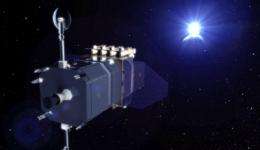Solar Dynamics Observatory Set to Launch Feb. 9

(PhysOrg.com) -- The Solar Dynamics Observatory, or SDO, is set to launch from Florida no earlier than 10:30 a.m. EST on Feb. 9, on an unprecedented mission to study the sun and its dynamic behavior. Onboard telescopes will scrutinize sunspots and solar flares using more pixels and colors than any other observatory in the history of solar physics. And SDO will reveal the sun’s hidden secrets in a prodigious rush of pictures.
The Solar Dynamics Observatory (SDO) will be taking a closer look at the Sun, the source of all Space Weather. Space Weather affects not only our lives here on Earth, but the Earth itself, and everything outside its atmosphere (astronauts and satellites out in space and even the other planets).
The Sun, our closest star, is still a great mystery to scientists. SDO will help us understand where the Sun's energy comes from, how the inside of the Sun works, and how energy is stored and released in the Sun's atmosphere... yes, the Sun has an atmosphere! By better understanding the Sun and how it works, we will be able to better predict and better forecast the "weather out in space" providing earlier warnings to protect our astronauts and satellites floating around out there.
SDO is the first satellite under the Living with a Star (LWS) program at NASA. The spacecraft is being designed to fly for five years. However, since satellites go through a lot of testing and retesting, they often keep working long past their initial mission life. SOHO for example, which was built to fly for five years, in 2005 celebrated its 10 year anniversary in 2005!
SDO is unlike any other satellite. It will be collecting huge amounts of data everyday. In fact SDO will produce enough data to fill a single CD every 36 seconds...
OK, so it will produce a lot of data, but what else makes it special?
Many satellites share a ground system (place on the ground where they send data and photographs) and have recording systems to save the data collected until they can talk to their ground station. Because SDO has no recording system and will be collecting so much data, the SDO mission has to build its very OWN ground station. For this to be possible, SDO has to be placed in a geosynchronous orbit (GEO). This means that it will rotate at the same speed as the Earth and will always be directly above and in constant communication with its ground station in New Mexico.
Provided by JPL/NASA





















